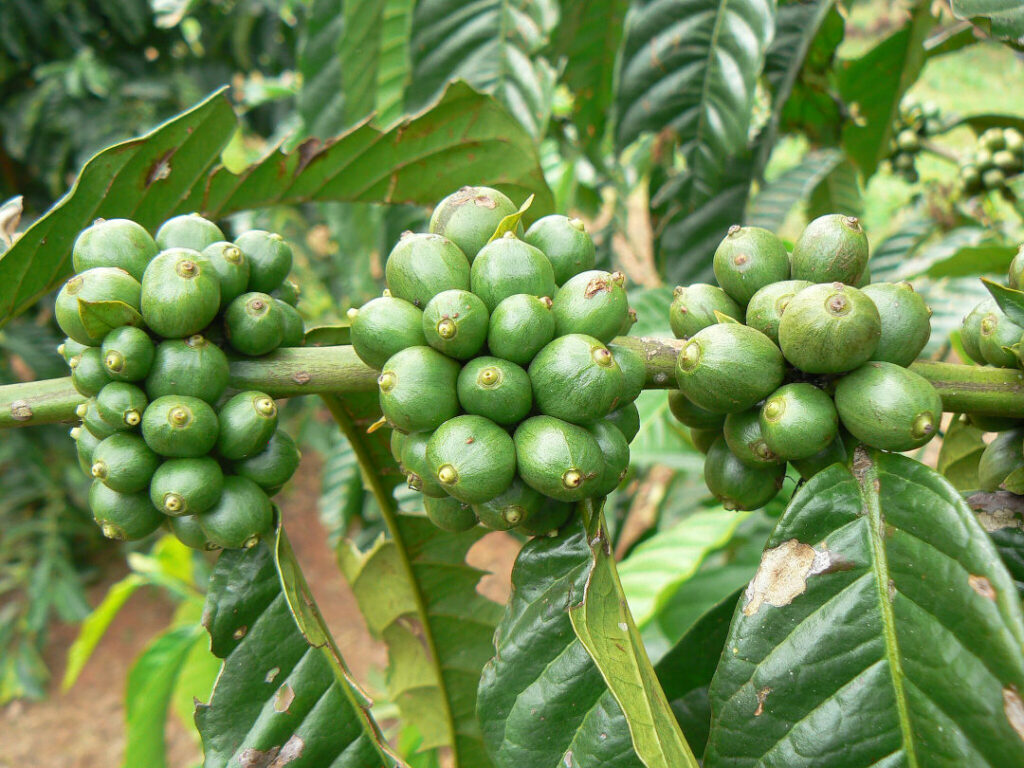
Nathan leibel, CC BY-SA 3.0
Uganda
Coffee
Coffea

Nathan leibel, CC BY-SA 3.0
General Description / Cultural Significance
Coffee is one of the most sacred and traditional crops in Uganda. It is used in celebrations and when making agreements and welcoming visitors. Traditionally, Robusta coffee beans were used to unite families. During this sacred ritual, a Robusta coffee cherry would be split in two and each person would eat a bean from inside the cherry. Thereafter, the spirit of the coffee bean would connect the families and their relatives.
Canephora (Robusta) coffee plants are native to the Ugandan Kampala Forest and Lake Victoria Crescent, and the country is considered the birthplace of Robusta coffee. Uganda also produces Arabica coffee which was introduced to the nation by Ethiopia in the 1900s. The production of Arabica coffee takes place mostly along the Eastern and Western regions of Uganda, while Robusta farming takes place in Central Uganda due to its lower altitude and warmer climate. Arabica coffee is often preferred since it is milder and less bitter than Robusta coffee. However, Arabica coffee plants are much more vulnerable to disease and poor weather conditions.
Across Uganda, coffee is produced on small farms averaging less than 5 acres, providing a livelihood for 20% of the population. Approximately 95% of Uganda’s coffee production is exported, making it a major foreign exchange earner for Uganda.
Climate Change / Conservation Status
Uganda lies within a humid and tropical equatorial climate zone that has been perfect for the coffee plant. Due to climate change, the country continues to experience increased and erratic rainfall, as well as droughts, rising water levels, and storms. The increase in rainfall has led to a growing frequency of river flooding, mudslides, and landslides. These extreme weather events threaten the loss of crops, livestock, and communities across Uganda. In Uganda, the agricultural sector employs 80% of the country’s labor force and supplies 85% of Ugandan exports. Such reliance on agricultural production means that Uganda’s economy is highly vulnerable to the effects of climate change.
Coffee is one of many agricultural products that Uganda exports. Growing coffee has long been a part of Ugandan people’s cultural heritage. They know the plant and its smell even though it was later that they moved from the production of coffee to the consumption of it.
Unfortunately, climate change and higher temperatures are reducing the areas that can successfully grow coffee plants. The rising temperatures are exposing coffee plants to more pests and diseases, weakening the crop and the country’s overall production of coffee beans. There are few adaption strategies, so the income of thousands of small farmers is also under threat.
Sources
A Taste of Where Coffee Began. 2018. World Itineraries. Available from https://worlditineraries.co/2018/04/12/a-taste-of-where-coffee-began/
Brennan, S. 2023. Ugandan Coffee: History, Brewing Tips & Flavors. Coffee Affection. Available from https://coffeeaffection.com/ugandan-coffee/
Climate Change threatens coffee production. 2013. Daily Monitor. Available from https://www.monitor.co.ug/uganda/magazines/farming/climate-change-threatens-coffee-production-1537246
Coffee in Uganda: Culture, Heritage and Economy. 2019. Slow Food Foundation. Available from https://www.slowfood.com/coffee-in-uganda-culture-heritage-and-economy/#:~:text=Coffee%20is%20one%20of%20the,new%20friendships%20and%20new%20homes.
Climate Change threatens coffee production. 2013. Daily Monitor. Available from https://www.monitor.co.ug/uganda/magazines/farming/climate-change-threatens-coffee-production-1537246
Enabling Farmers to Adapt to Climate Change: Uganda. United Nations Climate Change. Available from https://unfccc.int/climate-action/momentum-for-change/ict-solutions/enabling-farmers-to-adapt-to-climate-change
Exploring coffee consumption in Uganda. 2021. Perfect Daily Grind. Available from https://perfectdailygrind.com/2021/01/exploring-coffee-consumption-in-uganda/
Jassogne, L, Laderach, P, and Asten, Piet Van. 2013. The Impact of Climate Change on Coffee in Uganda. Oxfam Research Reports. https://ciaotest.cc.columbia.edu/wps/oxfam/0027961/f_0027961_22770.pdf
Jassogne, L, Laderach, P, and Asten, Piet Van. 2013. The Impact of Climate Change on Coffee in Uganda: Lessons from a case study in the Rwenzori Mountains: Overview. Oxfam. Available fromhttps://policy-practice.oxfam.org/resources/the-impact-of-climate-change-on-coffee-in-uganda-lessons-from-a-case-study-in-t-277813/
Kakumba, Makanga R. 2022. AD547: Climate change worsens life in Uganda; citizens want collective action to mitigate it. Afrobarometer. Available from https://www.afrobarometer.org/publication/climate-change-worsens-life-in-uganda-citizens-want-collective-action-to-mitigate-it/
Permanent Mission of the Republic of Uganda to the United Nations. This statement can be found on the World Sensorium original website.
Praise, M. 2022. Climate Change in Uganda and its visible effects. We Are Restless. Available from https://wearerestless.org/2022/02/23/climate-change-in-uganda-and-its-visible-effects/
The Uganda Coffee Industry. Uganda Coffee Federation. Available from https://ugandacoffeefederation.org/resource-center/uganda-coffee-industry/#:~:text=While%20Arabica%20was%20introduced%20at,of%20Ugandan%20life%20for%20centuries.
Uganda. Climate Change Knowledge Portal. Available from https://climateknowledgeportal.worldbank.org/country/uganda/vulnerability
Uganda. Climatelinks. Available from https://www.climatelinks.org/countries/uganda
Uganda Coffee. 2021. Weaverscoffee.com Available from https://weaverscoffee.com/blogs/blog/uganda-and-coffee

